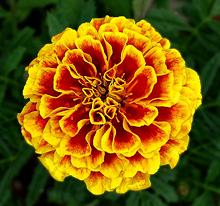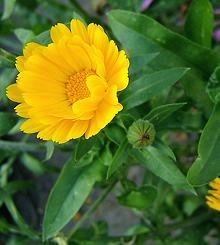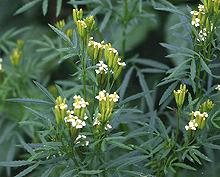
There are two genera of subfamily Astroideae that are commonly called "Marigold", one from the Old World, one from the New World. Ironically, the New World genus now has greater culinary importance then the Old World genus. There are others, including Huacatay, which has greater culinary importance than either of the well known ones. Photo of French Marigold by i_am_jim distributed under license Creative Commons Attribution-ShareAlike v4.0 international.
More on Daisy Herbs & Flowers

[Calendula officinalis of subfamily Asteroideae]
This plant, probably from southern Europe, is well known in North
America as a medicinal tea ingredient and for fresh petals scattered
on salads to add color interest. Fresh leaves have been used in salads
and as a pot herb, but palatability varies with variety. Flowers and
sometimes leaves were once commonly used in soups in Germany, thus
the name "Pot Marigold".
Photo of C. officinalis by Wildfeuer distributed
under license Creative Commons
Attribution-ShareAlike v3.0 unported.

 [Imeruli Shaphrani (Georgia); Tagetes patula alt Tagates
remotiflora]
[Imeruli Shaphrani (Georgia); Tagetes patula alt Tagates
remotiflora]
This plant is native to the highlands of southern Mexico and Guatemala, but has become widespread for decorative, aromatic and culinary uses. In the cuisine of Georgia (former Soviet Republic of), marigold petals (Tagetes patula) are a very important herbal flavoring. The dried petals are very aromatic. Powdered, they add both color and an earthy aroma to many recipes. Marigolds are also fed to chickens to get a nice rich color in the yolks of their eggs. Unfortunately dried petals are very difficult to find in North America. About the only way to get them is to grow your own marigolds. Calendula petals are as close as we can buy. They are aromatic but are not the same.
This plant is often used in gardening as a companion plant,
providing some protection against bacteria and insects both above
and below ground. It should not be planted near legumes or other
nitrogen fixing plants. The essential oil has a number of medicinal
uses. Photo by Dori distributed under license Creative Commons
Attribution-ShareAlike v3.0 unported.
 [Black Mint, Muster John Henry, Southern Marigold, Stinking Roger,
Wild marigold; Anisillo (Spanish); Chinchilla, Chiquilla, Chilca,
Zuico, Suico (South America); Huacatay (Peru); Huacataya (Bolivia);
Tagetes minuta]
[Black Mint, Muster John Henry, Southern Marigold, Stinking Roger,
Wild marigold; Anisillo (Spanish); Chinchilla, Chiquilla, Chilca,
Zuico, Suico (South America); Huacatay (Peru); Huacataya (Bolivia);
Tagetes minuta]
This plant is native to western South America, but has been
naturalized in numerous areas in Australasia, Asia, North America,
Europe and Africa. It has a weedy, vertical growth habit up to 6 feet
tall. It has long been used as a culinary flavoring and tea in
Ecuador, Peru, Chile, and Bolivia. There are also products made
from Huacatay that are more available in North America than the
fresh plant.
Details and Cooking.
Photo by Paul Venter distributed under license
Creative Commons
Attribution-ShareAlike v3.0 unported.